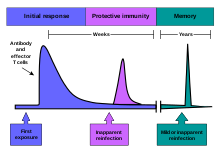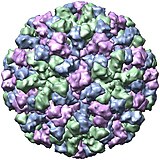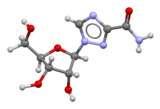Portal:Viruses
The Viruses Portal
Welcome!

Viruses are small infectious agents that can replicate only inside the living cells of an organism. Viruses infect all forms of life, including animals, plants, fungi, bacteria and archaea. They are found in almost every ecosystem on Earth and are the most abundant type of biological entity, with millions of different types, although only about 6,000 viruses have been described in detail. Some viruses cause disease in humans, and others are responsible for economically important diseases of livestock and crops.
Virus particles (known as virions) consist of genetic material, which can be either DNA or RNA, wrapped in a protein coat called the capsid; some viruses also have an outer lipid envelope. The capsid can take simple helical or icosahedral forms, or more complex structures. The average virus is about 1/100 the size of the average bacterium, and most are too small to be seen directly with an optical microscope.
The origins of viruses are unclear: some may have evolved from plasmids, others from bacteria. Viruses are sometimes considered to be a life form, because they carry genetic material, reproduce and evolve through natural selection. However they lack key characteristics (such as cell structure) that are generally considered necessary to count as life. Because they possess some but not all such qualities, viruses have been described as "organisms at the edge of life".
Selected disease
Polio, also called poliomyelitis or infantile paralysis, was one of the most feared childhood diseases of the 20th century. Poliovirus, the causative agent, only naturally infects humans and spreads via the faecal–oral route. Most infections cause no or minor symptoms. In around 1% of cases, the virus enters the central nervous system, causing aseptic meningitis. There it can preferentially infect and destroy motor neurons, leading in 0.1–0.5% of cases to muscle weakness and acute flaccid paralysis. Spinal polio accounts for nearly 80% of paralytic cases, with asymmetric paralysis of the legs being typical; in a quarter of these cases permanent severe disability results. Bulbar involvement is rare, but in severe cases the virus can prevent breathing by affecting the phrenic nerve, so that patients require mechanical ventilation with an iron lung or similar device.
Depictions in ancient art show that the disease has existed for thousands of years. The virus was an endemic pathogen until the 1880s, when major epidemics began to occur in Europe and later the United States. Polio vaccines were developed in the 1950s and a global eradication campaign started in 1988. The annual incidence of wild-type disease fell from many hundreds of thousands to 22 in 2017, but has since resurged to a few hundreds.
Selected image
Aedes aegypti can transmit the chikungunya, dengue, yellow fever and Zika viruses. The mosquito is widespread in tropical and subtropical regions, with mosquito control being key to disease prevention.
Credit: United States Department of Agriculture (2000)
In the news
26 February: In the ongoing pandemic of severe acute respiratory syndrome coronavirus 2 (SARS-CoV-2), more than 110 million confirmed cases, including 2.5 million deaths, have been documented globally since the outbreak began in December 2019. WHO
18 February: Seven asymptomatic cases of avian influenza A subtype H5N8, the first documented H5N8 cases in humans, are reported in Astrakhan Oblast, Russia, after more than 100,0000 hens died on a poultry farm in December. WHO
14 February: Seven cases of Ebola virus disease are reported in Gouécké, south-east Guinea. WHO
7 February: A case of Ebola virus disease is detected in North Kivu Province of the Democratic Republic of the Congo. WHO
4 February: An outbreak of Rift Valley fever is ongoing in Kenya, with 32 human cases, including 11 deaths, since the outbreak started in November. WHO
21 November: The US Food and Drug Administration (FDA) gives emergency-use authorisation to casirivimab/imdevimab, a combination monoclonal antibody (mAb) therapy for non-hospitalised people twelve years and over with mild-to-moderate COVID-19, after granting emergency-use authorisation to the single mAb bamlanivimab earlier in the month. FDA 1, 2
18 November: The outbreak of Ebola virus disease in Équateur Province, Democratic Republic of the Congo, which started in June, has been declared over; a total of 130 cases were recorded, with 55 deaths. UN
Selected article
The immune system is a system of structures and processes within an organism that protects against disease. It must detect a wide variety of pathogens – from viruses to parasitic worms – distinguish them from the organism's own healthy tissue, and neutralise them. Simple unicellular organisms such as bacteria have enzymes that protect against bacteriophage infections. Other basic immune mechanisms, including phagocytosis, antimicrobial peptides called defensins, and the complement system, evolved in ancient eukaryotes and are found in plants and invertebrates.
Humans and most other vertebrates have more sophisticated defence mechanisms, including the ability to adapt over time to recognise specific pathogens more efficiently. Adaptive immunity creates immunological memory after an initial response to a specific pathogen, leading to an enhanced response to subsequent encounters with that same pathogen. This process of acquired immunity is the basis of vaccination. Viruses and other pathogens can rapidly evolve to evade immune detection, and some viruses, notably HIV, cause the immune system to function less effectively.
Selected outbreak
The 2001 foot-and-mouth outbreak included 2,000 cases of the disease in cattle and sheep across the UK. The source was a Northumberland farm where pigs had been fed infected meat that had not been adequately sterilised. The initial cases were reported in February. The disease was concentrated in western and northern England, southern Scotland and Wales, with Cumbria being the worst-affected area. A small outbreak occurred in the Netherlands, and there were a few cases elsewhere in Europe.
The UK outbreak was controlled by the beginning of October. Control measures included stopping livestock movement and slaughtering over 6 million cows and sheep. Public access to farmland and moorland was also restricted (pictured), greatly reducing tourism in affected areas, particularly in the Lake District. Vaccination was used in the Netherlands, but not in the UK due to concerns that vaccinated livestock could not be exported. The outbreak cost an estimated £8 billion in the UK.
Selected quotation
| “ | Viruses are living chemicals... | ” |
Recommended articles
Viruses & Subviral agents: bat virome • elephant endotheliotropic herpesvirus • HIV • introduction to viruses![]() • Playa de Oro virus • poliovirus • prion • rotavirus
• Playa de Oro virus • poliovirus • prion • rotavirus![]() • virus
• virus![]()
Diseases: colony collapse disorder • common cold • croup • dengue fever![]() • gastroenteritis • Guillain–Barré syndrome • hepatitis B • hepatitis C • hepatitis E • herpes simplex • HIV/AIDS • influenza
• gastroenteritis • Guillain–Barré syndrome • hepatitis B • hepatitis C • hepatitis E • herpes simplex • HIV/AIDS • influenza![]() • meningitis
• meningitis![]() • myxomatosis • polio
• myxomatosis • polio![]() • pneumonia • shingles • smallpox
• pneumonia • shingles • smallpox
Epidemiology & Interventions: 2007 Bernard Matthews H5N1 outbreak • Coalition for Epidemic Preparedness Innovations • Disease X • 2009 flu pandemic • HIV/AIDS in Malawi • polio vaccine • Spanish flu • West African Ebola virus epidemic
Virus–Host interactions: antibody • host • immune system![]() • parasitism • RNA interference
• parasitism • RNA interference![]()
Methodology: metagenomics
Social & Media: And the Band Played On • Contagion • "Flu Season" • Frank's Cock![]() • Race Against Time: Searching for Hope in AIDS-Ravaged Africa
• Race Against Time: Searching for Hope in AIDS-Ravaged Africa![]() • social history of viruses
• social history of viruses![]() • "Steve Burdick" • "The Time Is Now" • "What Lies Below"
• "Steve Burdick" • "The Time Is Now" • "What Lies Below"
People: Brownie Mary • Macfarlane Burnet![]() • Bobbi Campbell • Aniru Conteh • people with hepatitis C
• Bobbi Campbell • Aniru Conteh • people with hepatitis C![]() • HIV-positive people
• HIV-positive people![]() • Bette Korber • Henrietta Lacks • Linda Laubenstein • Barbara McClintock
• Bette Korber • Henrietta Lacks • Linda Laubenstein • Barbara McClintock![]() • poliomyelitis survivors
• poliomyelitis survivors![]() • Joseph Sonnabend • Eli Todd • Ryan White
• Joseph Sonnabend • Eli Todd • Ryan White![]()
Selected virus
Noroviruses are a genus of non-enveloped, single-stranded RNA viruses in the family Caliciviridae. The positive-sense RNA genome is approximately 7500 nucleotides long. Known noroviruses fall into five different genogroups (GI–GV); three groups infect humans, the other two mice, and cattle and other bovines. All are considered strains of a single species, Norwalk virus.
Noroviruses are extremely contagious, with fewer than 20 virus particles being infectious. They are transmitted directly from person to person and indirectly via contaminated water and food. After infection, the virus replicates in the small intestine, causing acute gastroenteritis, which develops 12–48 hours after exposure and lasts for 24–72 hours. The characteristic symptoms include nausea, forceful vomiting, watery diarrhoea and abdominal pain. Infection is usually self-limiting and rarely severe. Noroviruses cause 18% of acute gastroenteritis episodes in humans, with around 685 million cases and 200,000 deaths every year, mainly in very young, elderly or immunosuppressed people. No vaccine is available. Hand washing with soap and water is effective in reducing transmission.
Did you know?
- ...that the protein ASF/SF2 (molecular image pictured) is involved in the development of the human heart and the replication of HIV-1?
- ...that in February 2020, Neil Ferguson and his team believed that significantly more people in China had been infected with the 2019 novel coronavirus than had been reported?
- ...that the outbreak of Ebola in Bundibugyo District in Uganda in 2007 was caused by a novel strain of the Ebola virus?
- ...that virologist John R. Paul blamed better hygiene for polio's spread in the 20th century, saying early exposure to poliovirus would have given immunity?
- ...that a novel human polyomavirus is associated with Merkel cell carcinoma, a rare and highly aggressive form of skin cancer?
Selected biography
Ali Maow Maalin (1954 – 22 July 2013) was a hospital cook and health worker from Merca, Somalia, who is the last person in the world known to be infected with naturally occurring smallpox. Although he worked in the local smallpox eradication programme, he had not been successfully vaccinated. In October 1977, he was infected with the Variola minor strain of the virus while driving two children with smallpox symptoms to quarantine. He did not experience complications and made a full recovery. An aggressive containment campaign was successful in preventing an outbreak, and smallpox was declared to have been eradicated globally by the World Health Organization (WHO) two years later.
In later life, Maalin volunteered for the successful poliomyelitis eradication campaign in Somalia. He worked for WHO as a local coordinator with responsibility for social mobilisation, and spent several years travelling across Somalia, vaccinating children and educating communities. He encouraged people to be vaccinated by sharing his experiences with smallpox. He died of malaria while carrying out polio vaccinations after the reintroduction of poliovirus to the country in 2013.
In this month
May 1955: First issue of Virology; first English-language journal dedicated to virology
4 May 1984: HTLV-III, later HIV, identified as the cause of AIDS by Robert Gallo and coworkers
5 May 1939: First electron micrographs of tobacco mosaic virus taken by Helmut Ruska and coworkers
5 May 1983: Structure of influenza neuraminidase solved by Jose Varghese, Graeme Laver and Peter Colman
8 May 1980: WHO announced formally the global eradication of smallpox
11 May 1978: SV40 sequenced by Walter Fiers and coworkers
12 May 1972: Gene for bacteriophage MS2 coat protein is sequenced by Walter Fiers and coworkers, the first gene to be completely sequenced
13 May 2011: Boceprevir approved for the treatment of chronic hepatitis C virus (HCV) infection, the first direct-acting antiviral for HCV
14 May 1796: Edward Jenner inoculated James Phipps (pictured) with cowpox
15/16 May 1969: Death of Robert Rayford, the earliest confirmed case of AIDS outside Africa
18 May 1998: First World AIDS Vaccine Day
20 May 1983: Isolation of the retrovirus LAV, later HIV, by Luc Montagnier, Françoise Barré-Sinoussi and coworkers
23 May 2011: Telaprevir approved for the treatment of chronic HCV infection
25 May 2011: WHO declared rinderpest eradicated
31 May 1937: First results in humans from the 17D vaccine for yellow fever published by Max Theiler and Hugh H. Smith
Selected intervention
Ribavirin is a nucleoside analogue that mimics the nucleoside guanosine. It shows some activity against a broad range of DNA and RNA viruses, but is less effective against dengue fever, yellow fever and other flaviviruses. The drug was first synthesised in the early 1970s by Joseph T. Witkowski and Roland K. Robins. Ribavirin's main current use is against hepatitis C, in combination with pegylated interferon, nucleotide analogues and protease inhibitors. It has been used in the past in an aerosol formulation against respiratory syncytial virus-related diseases in children. Ribavirin has been used in combination as part of an experimental treatment for rabies. It is also the only available treatment for the viruses causing some viral haemorrhagic fevers, including Lassa fever, Crimean–Congo haemorrhagic fever and hantavirus disease, but is ineffective against the filovirus diseases, Ebola and Marburg. Clinical use is limited by the drug building up in red blood cells to cause haemolytic anaemia.
Subcategories
Subcategories of virology:
Topics
Things to do
- Comment on what you like and dislike about this portal
- Join the Viruses WikiProject
- Tag articles on viruses and virology with the project banner by adding {{WikiProject Viruses}} to the talk page
- Assess unassessed articles against the project standards
- Create requested pages: red-linked viruses | red-linked virus genera
- Expand a virus stub into a full article, adding images, citations, references and taxoboxes, following the project guidelines
- Create a new article (or expand an old one 5-fold) and nominate it for the main page Did You Know? section
- Improve a B-class article and nominate it for Good Article
 or Featured Article
or Featured Article status
status - Suggest articles, pictures, interesting facts, events and news to be featured here on the portal
WikiProjects & Portals
 WikiProject Viruses
Related WikiProjects
WikiProject Viruses
Related WikiProjects
Medicine • Microbiology • Molecular & Cellular Biology • Veterinary Medicine
Related PortalsAssociated Wikimedia
The following Wikimedia Foundation sister projects provide more on this subject:
-
Commons
Free media repository -
Wikibooks
Free textbooks and manuals -
Wikidata
Free knowledge base -
Wikinews
Free-content news -
Wikiquote
Collection of quotations -
Wikisource
Free-content library -
Wikispecies
Directory of species -
Wikiversity
Free learning tools -
Wiktionary
Dictionary and thesaurus


















